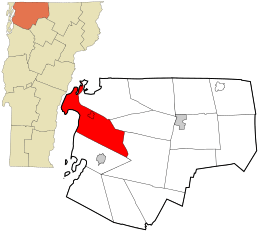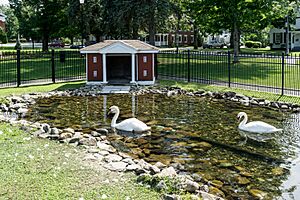Swanton (town), Vermont facts for kids
Quick facts for kids
Town of Swanton
|
|
|---|---|

A Civil War memorial stands in Swanton's Village Green, in the center of town.
|
|

Location in Franklin County and the state of Vermont.
|
|
| Country | United States |
| State | Vermont |
| County | Franklin |
| Communities | Swanton Fonda Greens Corners Maquam Skeels Corners West Swanton |
| Area | |
| • Total | 61.7 sq mi (159.7 km2) |
| • Land | 48.0 sq mi (124.4 km2) |
| • Water | 13.6 sq mi (35.3 km2) |
| Elevation | 150 ft (50 m) |
| Population
(2020)
|
|
| • Total | 6,701 |
| • Density | 108.68/sq mi (41.960/km2) |
| Time zone | UTC-5 (Eastern (EST)) |
| • Summer (DST) | UTC-4 (EDT) |
| ZIP Codes | |
| Area code(s) | 802 |
| FIPS Code | 50-011-71725 |
| GNIS feature ID | 1462225 |
Swanton is a town located in Franklin County, Vermont, in the United States. It is known as a New England town. In 2020, about 6,701 people lived here. The town also includes the smaller village of Swanton.
Contents
History of Swanton
The town of Swanton was officially created in 1763. It was part of the New Hampshire Grants, which were land areas given out by the governor of New Hampshire, Benning Wentworth. The town was named after Captain William Swanton. He was a British Army officer who traveled through this area during the French and Indian War.
Long before that, French settlers had land grants here starting in 1734. There were even small French communities and a Catholic mission as early as 1740. These early settlers from Quebec used a water route to reach the Missisquoi River near what is now Swanton Falls.
None of the first people who received land from Governor Wentworth actually moved to Swanton. They chose to sell or trade their land instead. Swanton was very close to the border with New France (later Quebec). Because of this, not many people from the British colonies settled there in the 1760s and 1770s. Even after the United States became independent, or when Vermont was its own republic, the area remained mostly empty. By 1786, a man named Ira Allen owned most of the original land shares.
In 2013, scientists found very old human tools near the Missisquoi River. Some of these tools were about 7,000 years old! One special stone object, called a Neville-type stone, might have been attached to a spear.
Geography and Location
Swanton is in the western part of Franklin County. To its west, you'll find Lake Champlain and Grand Isle County. The town's border even reaches the Canada–United States border within Missisquoi Bay. The city of St. Albans, which is the main town for Franklin County, is to the south of Swanton.
Major roads like Interstate 89 and U.S. Route 7 run through Swanton. They go from north to south. US 7 goes right through the village of Swanton. Interstate 89 has an exit (Exit 21) just east of the village. Other important roads include Vermont Route 78, Vermont Route 36, Vermont Route 207, and Vermont Route 105. These roads help people travel to nearby towns and across Lake Champlain.
The United States Census Bureau says that Swanton covers about 159.7 square kilometers (61.7 square miles). About 124.4 square kilometers (48.0 square miles) of this is land. The rest, about 35.3 square kilometers (13.6 square miles), is water. This means a good part of Swanton is covered by water, like parts of Lake Champlain.
The village of Swanton is in the north-central part of the town. Another community called Fonda is in the south-central part. Both of these are located along US 7. A large part of the Missisquoi National Wildlife Refuge is also in Swanton. This refuge is where the Missisquoi River flows into Lake Champlain. It's a special place for wildlife.
Population and People
| Historical population | |||
|---|---|---|---|
| Census | Pop. | %± | |
| 1790 | 74 | — | |
| 1800 | 858 | 1,059.5% | |
| 1810 | 1,657 | 93.1% | |
| 1820 | 1,607 | −3.0% | |
| 1830 | 2,158 | 34.3% | |
| 1840 | 2,313 | 7.2% | |
| 1850 | 2,824 | 22.1% | |
| 1860 | 2,678 | −5.2% | |
| 1870 | 2,866 | 7.0% | |
| 1880 | 3,079 | 7.4% | |
| 1890 | 3,231 | 4.9% | |
| 1900 | 3,745 | 15.9% | |
| 1910 | 3,628 | −3.1% | |
| 1920 | 3,343 | −7.9% | |
| 1930 | 3,433 | 2.7% | |
| 1940 | 3,543 | 3.2% | |
| 1950 | 3,740 | 5.6% | |
| 1960 | 3,946 | 5.5% | |
| 1970 | 4,622 | 17.1% | |
| 1980 | 5,141 | 11.2% | |
| 1990 | 5,636 | 9.6% | |
| 2000 | 6,203 | 10.1% | |
| 2010 | 6,427 | 3.6% | |
| 2020 | 6,701 | 4.3% | |
| U.S. Decennial Census | |||
In 2000, there were 6,203 people living in Swanton. These people lived in 2,329 households, and 1,700 of these were families. The population density was about 128 people per square mile.
Many households in Swanton had children under 18 living there (about 35.6%). Most households were married couples living together (57.4%). About 20.3% of all households were made up of people living alone.
The population in Swanton is spread out across different age groups. About 27.7% of the people were under 18 years old. About 12.5% were 65 years old or older. The average age of people in Swanton was 36 years.
Local Groups
The Abenaki Nation of Missisquoi is based in Swanton. This group is also called the Mississquoi Abenaki Tribe. They say they are descendants of the original Missisquoi people. This organization is recognized by the state of Vermont. However, it is not federally recognized as a Native American tribe by the U.S. government.
The Royal Swans of Swanton
In 1961, something very special happened in Swanton. Queen Elizabeth II of England gave a pair of her Royal Swans to the town! This gift was part of Swanton's annual Summer Festival. Members of the Swanton Chamber of Commerce named the swans Sam (after Uncle Sam) and Betty (after Queen Elizabeth).
The idea for the swans came from a summer visitor named Harry Gibbons. He worked in public relations and suggested the idea to the Chamber. They sent a letter to Buckingham Palace, and the Queen agreed! The swans came from a place in England called Hickling Broad.
These swans were caught during a special event called "swan-upping." This is when members of old English guilds mark the Queen's swans. They put a small mark on their beaks to show they belong to the Queen.
The first swans lived a long life and passed away before summer 2016. After two years, a new pair of swans was brought to Swanton. They are also named Sam and Betty. These new swans are not related to the first ones, but they are still known as the Royal Swans. You can find them in Village Green Park, where they live in a special area surrounded by a black fence.
Notable People from Swanton
- Stephen F. Brown, an officer in the Union Army during the American Civil War
- Lucien B. Caswell, a US congressman from Wisconsin
- James Fisk, who served in both the United States House of Representatives and the United States Senate
- Oscar Clark Hathaway, a state senator in Wisconsin
- Albert B. Jewett, a commander of the 10th Vermont Infantry Regiment during the American Civil War
- William B. La Selle, a state assemblyman in Wisconsin
- Albert Whittemore Sanborn, a state senator in Wisconsin
- M. Emmet Walsh, a famous actor
See also
 In Spanish: Swanton (Vermont) para niños
In Spanish: Swanton (Vermont) para niños


